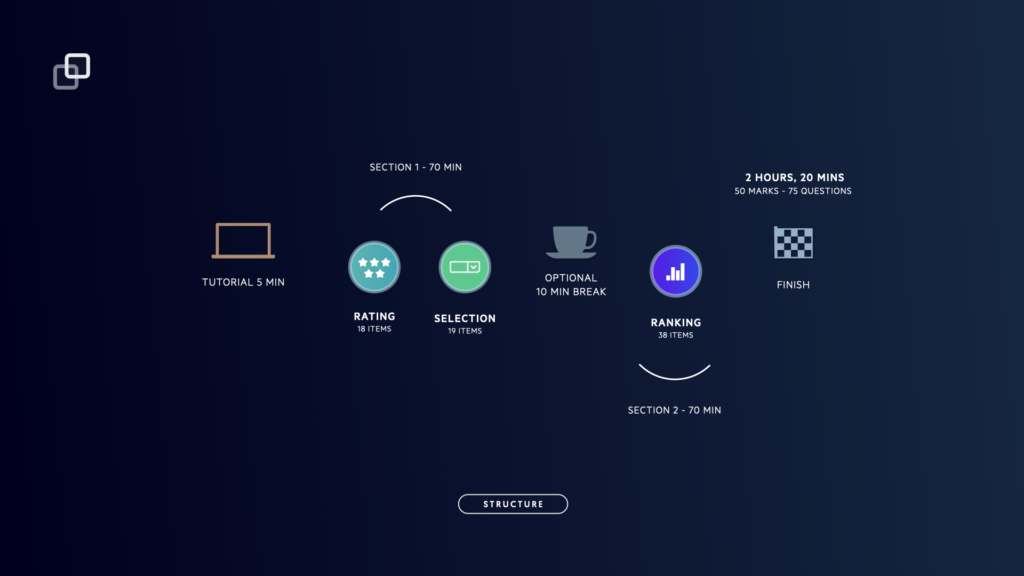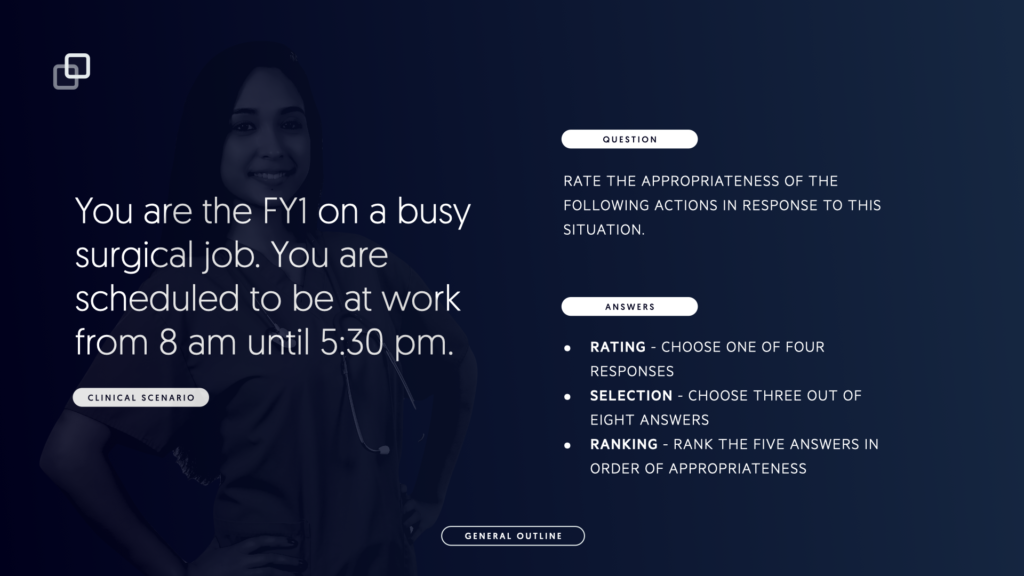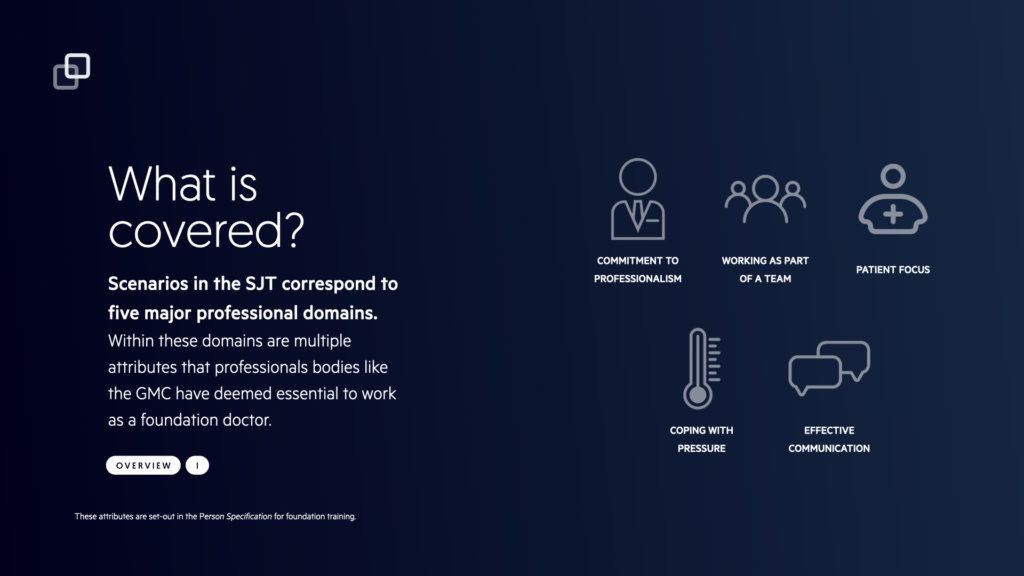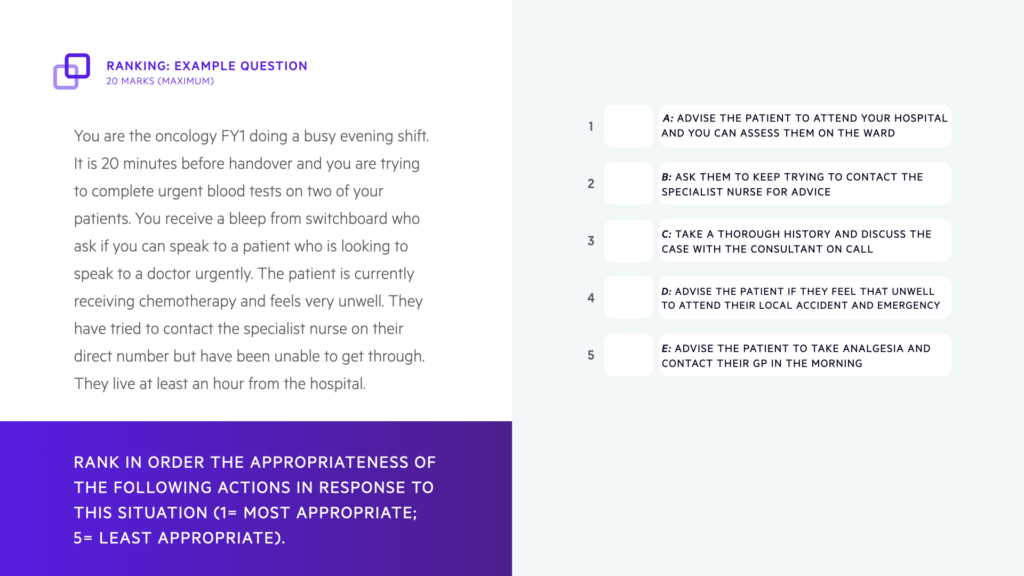Situational Judgement Test (SJT) 2022-23 – All you need to know… Top tips
All you need to know about the ever-dreaded SJT 2022/23. How scoring works, exam format, question types, common scenarios and our top tips!
Pulsenotes
I. Introduction
The situational judgement test (SJT) is a national, computer-based assessment. It forms an important part of the entry requirement into the UK foundation programme (UKFP).
The UKFP is a standardised two-year, work-based training programme, which bridges the gap between medical school and more specialist training. All medical students who apply to enter the UKFP will need to sit the SJT during that academic year in one of two test windows in December 2022 or January 2023.
The UKFP is a competitive programme that allocates students to a foundation school based on a national allocation process. This process combines the results of the SJT with the educational performance measure (EPM) to give a total score out of 100. All applicants will be given a unique rank based on this score, which is used to match students to foundation schools and subsequent programmes.
Scoring
The higher the score, the more likely the applicant is to be allocated to one of their top-choice foundation schools.
The SJT can be a daunting assessment because it is a single exam accounting for 50% of your total UKFP application score. This means it has a big influence on where you will be within the UK during your first two years as a doctor.
The SJT is unlike other assessments at medical school and does not test medical knowledge. Instead, the purpose of the SJT is to assess key attributes in the national person specification for being a foundation doctor (i.e. the skills, behaviours and values that are needed to be a good doctor). Taking into account these attributes, such as teamwork, communication and professionalism, it assesses your ability to respond to work-based scenarios that may be encountered during your first year as a foundation doctor. These attributes are based on the General Medical Council’s (GMC) ‘Good Medical Practice’ guidance that outlines professional values and ethical behaviour expected of all doctors.
Our SJT Crash Course!
At Pulsenotes, we have created a unique SJT crash course for 2022/23 to get you up to speed with the outline of the SJT exam, the underlying principles of what the test covers, and the key ethical guidance from the GMC.
We have combined these with an in-depth analysis of each question type and multiple worked examples to help you get the best possible score.
DON’T WORRY – with the right understanding, preparation and practice, you have every chance of being in the location you want to be for the UK foundation programme!
II. SJT format
The UKFP SJT is a computer-based assessment, that includes 75 questions across three different question types. The total length of the exam is 2 hours and 20 minutes with an optimal 10-minute break between sections.

The SJT presents applicants with a series of work-related situations that a foundation doctor may face in their first year. It asks through a series of different question formats, how you would respond to these situations.
The three question formats are:
- Rating (18 scenarios) – you need to rate one out of four answers in terms of their appropriateness or importance in relation to the question.
- Multiple-choice (19 scenarios) – you need to pick three answers from a total of eight that in combination provide the best solution to the question.
- Ranking (38 scenarios) – you need to rank, from 1-5, the appropriateness or importance of answers in relation to the question.

Within each of these question types there are three question formats:
- Actions – you need to rate, choose or rank the appropriateness of the following actions in response to the clinical scenario.
- Considerations – you need to rate, choose or rank the importance of the following considerations in response to the clinical scenario.
- Speech – you need to rate, choose or rank the most appropriate responses to the situation assuming they are all said in a polite way.
Important! – The work-based scenarios used in the SJT may include multimedia elements such as video-based questions and evolving dilemmas. Evolving dilemmas require the applicant to respond individually to up to three clinical scenarios that are linked by a common context (e.g. Part A, Part B, Part C). These types of scenarios are felt to be more representative of real workplace dilemmas, which tend to be multi-faceted.
III. What is covered?
The SJT tests the attributes needed to work as an effective foundation doctor. These attributes are based on the foundation programme person specification that map to five professional domains, which include:
- Commitment to professionalism
- Working as part of a team
- Patient focus
- Coping with pressure
- Effective communication
Each of these five professional domains incorporates several subdomains that will be tested throughout the SJT scenarios.

IV. How to prepare
The SJT is not about memorising facts or wrote learning answers.
Instead, it tests your ability to apply ethical principles and appropriate behaviour of a foundation doctor in response to realistic scenarios. Whilst this means you cannot revise for the exam in the traditional sense, you can definitely make sure you are well prepared and have developed a good technique for approaching questions and ethical problems.
It is vital that all students planning to sit the SJT read through the latest GMC ethical guidelines. Preferably, you should do this several times to pick up the general themes and advice laid out to doctors. In addition, you need to be up to date with the essential ethical principles that are tested within the exam.
These include, but are not limited to:
- Confidentiality
- Capacity
- Consent
- End-of-life care
- Child protection
- Personal beliefs
- Chaperones
- Social media
Remember to work through the practice questions making sure to spend adequate time going through the answers and justification for the questions.
The UKFP has practice papers with answers that can be worked through. The Pearson VUE has an online practice paper to get you used to the computer system but does not provide answers.
There are many other resources available for practice questions, but some of these are outdated and others very poor quality. Therefore, you need to be careful with the resources you choose.
Remember, it is not the number of questions you review – but the quality of the preparation when tackling them that will help you get the best score.
Always ask yourself…
- Why was that the right answer?
- What were the key ethical problems in this question?
- How might the answer differ if the clinical scenario was changed?
V. Typical scenarios
The SJT will present applicants with a variety of work-based scenarios that map to the many areas of the curriculum domains. There are some common scenarios that will be faced frequently in the exam such as confidentiality, resolving conflict within a team, and escalating concerns.
We advise that you pay close attention to how the following scenarios are structured, the best responses, and how they link to GMC guidance:
- Escalating concerns (e.g. knowing when and who to escalate concerns too)
- Duty of candour (e.g. the process of informing patients when things go wrong with care)
- Commitment to learning (e.g. keeping up with your personal and professional development)
- Procedures (e.g. not performing procedures beyond your capability as an FY1)
- Teamwork & resolving conflict (e.g. Rota issues, time management, being late, handover)
- Breaking bad news (e.g. knowing when, and when not, to break bad news as an FY1)
- Work/life balance (e.g. being realistic with time, having adequate rest)
- Social media (e.g. maintaining professional boundaries with patients)
- Documentation (e.g. records should be date stamped, timed, legible and signed)

VI. Top tips
There is no one way to approach the SJT. However, we have summarised our essential top tips for getting the best possible score on the day!
- Keep to time – time will go very quickly in the SJT so practice under pressure.
- Do not leave any question blank – there is no negative marking!
- Look at the question terminology – wording choice can affect your answers dramatically (e.g. advise versus confront)
- Look at the timeframe – is the situation an emergency (act in seconds to minutes), urgent (act in minutes to hours), routine (act in hours to days) or non-urgent (act in days to weeks)
- Always consider patient safety – maintaining patient safety is a priority in the SJT scenarios.
- Address the question – think about what specific problem is posed in the question.
- Know your limits as an FY1 – you must act within the limits of a Foundation Year 1 doctor.
Most importantly, try not to worry! The SJT can be daunting because it counts for so much about where you will be for the first two years of your life as a doctor. However, remember it is not the be-all and end-all, and will not define you as a doctor!
VII. GMC Guidance & other resources
The GMC has a series of important ethical guidance in the form of documents that help to guide medical practice. These cover a whole raft of ethical and legal responsibilities.
https://www.gmc-uk.org/ethical-guidance/ethical-guidance-for-doctors
In addition, medical indemnity companies can be a very good resource for specific ethical and legal issues that doctors may face including use of social media, death certification, gifts, and breaching confidentiality in the interests of the public to name a few.